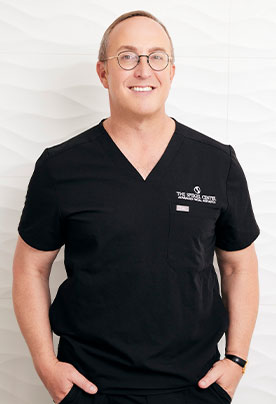
Listen, men, testosterone is a double-edged sword. On the one hand, it helps maintain muscles, sexual function, and strong bones. On the other hand, it can cause an increased risk of certain health issues, and, a form of testosterone, called dihydrotestosterone, or DHT, can bind to your hair follicles and increase the likelihood of hair loss.
Hair loss is something almost all men experience. By 45 more than 30% of men note some thinning or loss of hair, and almost all men experience hair loss by age 70. Most of the propensity to hair loss will be genetic in that it runs in the family. However, unlike Uncle Damon or Cousin Vin, you have options.
First, take good care of your hair. Use good hair care products, don’t over-style, don’t pull your hair too tight in a ponytail, and avoid hot hair dryers.
Next, help your hair have what it needs to grow. There are vitamin preparations that can create a conducive environment for hair to grow. In some cases, the proper supplements, such as Nutrafol™, can lead to a dramatic improvement by helping assure a strong supply of the nutrients the hair follicles need.
Of course, there are a number of oral and topical medications that can help as well. Remember DHT, the hormone that contributes to hair loss? Well, it is possible to limit the effect of DHT on the hair follicles by using medications such as finasteride or minoxidil. Finasteride is an oral medication that blocks the conversion of Testosterone to DHT. Minoxidil doesn’t block DHT but does work to help hair follicles get more blood flow (so more nutrients), and stimulate hair to grow. There are FDA and non-FDA preparations available so talk with your doctor for their best advice. These medications can now be specially compounded as a foam, cream, or gel that can be applied topically to the scalp. Finasteride, however, is most commonly given as a pill. For some people, these treatments will stop or even slightly reverse hair loss. One caveat is that you need to stay on them. Once you stop using the medication, the DHT will get right back to work and lead to permanent hair loss. Given that there is not much risk or time commitment to simply putting a liquid medication onto your hair or taking a pill orally, it could be worth the effort. We can help you sort out the right preparation for you and can help you get it compounded for the best efficacy.
Have you heard about Platelet Rich Plasma or PRP? Here we are again encouraging the existing hair on your head to gain strength and flourish. A small amount of blood is drawn from the arm, and the components of the blood are separated from one another to produce a liquid rich in nutrients and growth factors. This PRP is then injected into the scalp. Studies have shown that PRP injections can substantially improve hair density and appearance. PRP is a quick, comfortable, and effective way to maximize your hair quality and density.
When you need to do more or want a more permanent effect, hair grafts are the answer to your prayers. You may have noticed that for most men hair loss occurs in predictable and regular patterns. Most men see a receding hairline first on the sides at the front, as well as loss on top of the head at the crown. There is a hair loss classification system called the Norwood Scale which shows common types of hair loss ranging from Type 1 with some early recession at the corners to Type VII where there is almost total hair loss but for low around the ears and low around the back of the head.
The key to hair grafts is that hair from the back of your head tends to stay put and be resistant to DHT and falling out. Amazingly, it maintains that natural ability regardless of where it is. So, if you move hair from the back of the head to the front, it lasts and lasts even while the original front hair falls out. In prior years, people would remove a strip of the scalp in the back of the head and then cut out the hairs from that strip for movement into the front or top of the head. That worked nicely, but it left a long thin scar across the back of the head. That scar was well hidden unless you decided to cut your hair very short. It’s like a sunken ship appearing when the water gets low. That method of hair grafting was called FUT, for Follicular Unit Transplantation. This method does have some advantages, still. For example, there is no need to shave the head at all to take out the hair grafts individually.
More commonly people prefer FUE, for Follicular Unit Extraction. Here, instead of removing a strip of scalp with hair from the back of the head, individual hairs are removed through small circular sites, like a needle poke. These individual hairs are then moved to where we want them. With FUE we can harvest hair from anywhere the hair is present or the most dense areas, usually that’s on the back or side of the head.
And, did you know that hair can be placed anywhere? These FUE hair grafts can be put in the front of the hairline, at the sides, on the top, or even in the eyebrows, beard, or chest. The hair grafts are placed through small needle pokes which then heal and grow. Hair grafting is easy and comfortable. Bring your headphones and listen to a podcast or your favorite music. You just lean back and leave the grafting to us and our experts will have you on the right track in a day.
Did you find this article valuable? Did we miss anything you’d like to know about hair grafts and FUE near Boston? Let us know when you contact us at [email protected].





